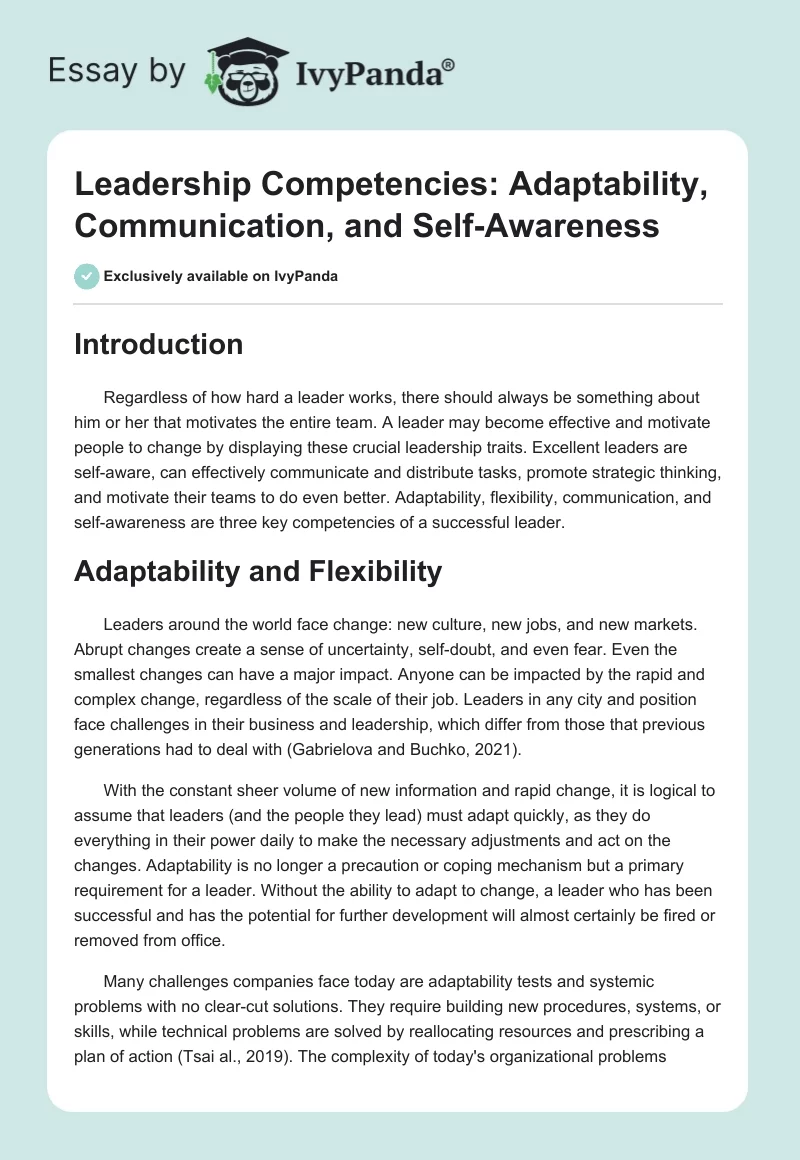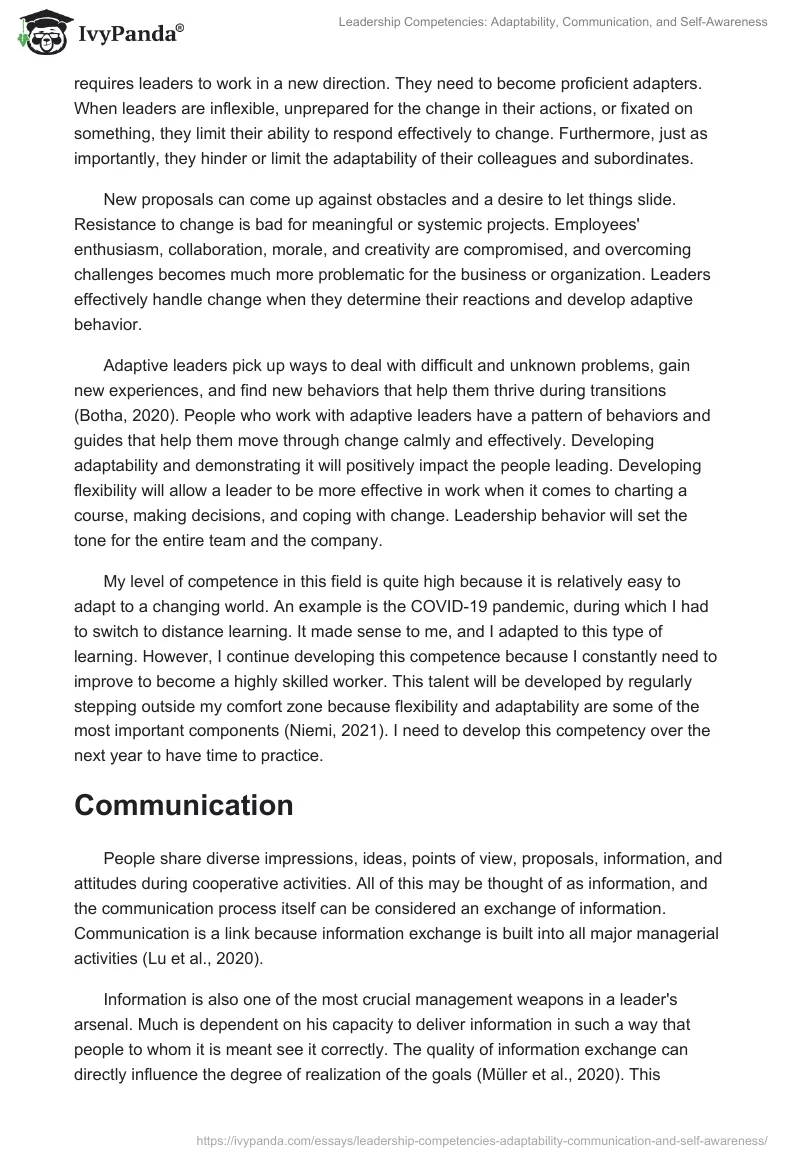Introduction
Regardless of how hard a leader works, there should always be something about him or her that motivates the entire team. A leader may become effective and motivate people to change by displaying these crucial leadership traits. Excellent leaders are self-aware, can effectively communicate and distribute tasks, promote strategic thinking, and motivate their teams to do even better. Adaptability, flexibility, communication, and self-awareness are three key competencies of a successful leader.
Adaptability and Flexibility
Leaders around the world face change: new culture, new jobs, and new markets. Abrupt changes create a sense of uncertainty, self-doubt, and even fear. Even the smallest changes can have a major impact. Anyone can be impacted by the rapid and complex change, regardless of the scale of their job. Leaders in any city and position face challenges in their business and leadership, which differ from those that previous generations had to deal with (Gabrielova and Buchko, 2021).
With the constant sheer volume of new information and rapid change, it is logical to assume that leaders (and the people they lead) must adapt quickly, as they do everything in their power daily to make the necessary adjustments and act on the changes. Adaptability is no longer a precaution or coping mechanism but a primary requirement for a leader. Without the ability to adapt to change, a leader who has been successful and has the potential for further development will almost certainly be fired or removed from office.
Many challenges companies face today are adaptability tests and systemic problems with no clear-cut solutions. They require building new procedures, systems, or skills, while technical problems are solved by reallocating resources and prescribing a plan of action (Tsai al., 2019). The complexity of today’s organizational problems requires leaders to work in a new direction. They need to become proficient adapters. When leaders are inflexible, unprepared for the change in their actions, or fixated on something, they limit their ability to respond effectively to change. Furthermore, just as importantly, they hinder or limit the adaptability of their colleagues and subordinates.
New proposals can come up against obstacles and a desire to let things slide. Resistance to change is bad for meaningful or systemic projects. Employees’ enthusiasm, collaboration, morale, and creativity are compromised, and overcoming challenges becomes much more problematic for the business or organization. Leaders effectively handle change when they determine their reactions and develop adaptive behavior.
Adaptive leaders pick up ways to deal with difficult and unknown problems, gain new experiences, and find new behaviors that help them thrive during transitions (Botha, 2020). People who work with adaptive leaders have a pattern of behaviors and guides that help them move through change calmly and effectively. Developing adaptability and demonstrating it will positively impact the people leading. Developing flexibility will allow a leader to be more effective in work when it comes to charting a course, making decisions, and coping with change. Leadership behavior will set the tone for the entire team and the company.
My level of competence in this field is quite high because it is relatively easy to adapt to a changing world. An example is the COVID-19 pandemic, during which I had to switch to distance learning. It made sense to me, and I adapted to this type of learning. However, I continue developing this competence because I constantly need to improve to become a highly skilled worker. This talent will be developed by regularly stepping outside my comfort zone because flexibility and adaptability are some of the most important components (Niemi, 2021). I need to develop this competency over the next year to have time to practice.
Communication
People share diverse impressions, ideas, points of view, proposals, information, and attitudes during cooperative activities. All of this may be thought of as information, and the communication process itself can be considered an exchange of information. Communication is a link because information exchange is built into all major managerial activities (Lu et al., 2020).
Information is also one of the most crucial management weapons in a leader’s arsenal. Much is dependent on his capacity to deliver information in such a way that people to whom it is meant see it correctly. The quality of information exchange can directly influence the degree of realization of the goals (Müller et al., 2020). This indicates that good communication is critical for individual and organizational success. Effective communication is characterized by accuracy, timeliness, targeting, feedback, and accessibility.
Ineffective communication is one of the main problems. One must learn how to lessen the frequency of inefficient communications by thinking thoroughly about communication at the individual and organizational levels. Successful leaders are those who can communicate effectively. They reflect the essence of the communication process, have strong oral and written communication skills, and understand how the environment influences information sharing.
Both formal communication and informal communication occur in an organization. Formal communication involves the interaction of subjects performing social roles within the framework of job and social responsibilities. Informal communication is focused on maintaining and developing relationships and solving personal problems and problems of group dynamics. Both formal and informal communication can be effective. The effectiveness of interaction and mutual supplementation of formal and informal communication networks largely determines the organization’s productivity and leadership’s effectiveness.
Often, when there is a need for more formal information, an informal communication network makes up for the lack of it. Transfer of formal information through informal networks leads to distortion of this information. The performance of informal communication functions of informing employees on key problems of vital activity leads to interference in the coordination of work of members of the organization. Depending on the influence of informal leaders and the degree of their loyalty to the official management of the organization, trust, and agreement with management decisions and management methods change the force and influence of the informal communication network.
This competence of mine needs to be improved because it needs to be developed. I know how to communicate verbally and in writing, but I must influence people through communication to become a top-notch professional. At this point, I need help communicating persuasively. Therefore, I will constantly be practicing formal and informal communication. Constant practice is a great way to develop communication proficiency (Toro et al., 2019). I intend to improve this competence in six months to handle the communicative part of leadership by the time I start my professional career.
Self-Awareness
Self-knowledge is not self-exploration or excessive self-absorption but a realistic assessment of abilities, shortcomings, achievements, mistakes, motivation, preferences, life position, and influence on others. The concepts of “self-knowledge” and “self-observation” may be associated with narcissism (Braddock, 2022). With one caveat: a real assessment of the situation will help build much more effective relationships with other people. If colleagues and subordinates know the leader better than he does and much more objectively assess his strengths and weaknesses, sooner or later, he will lose credibility. A leader, in turn, realizing his essence and influence on others soberly, will become more open and empathic and begin interacting with people without compromising his life principles. Self-knowledge involves nothing less than discovering one’s potential.
According to another well-known consulting firm, Green Peak Partners, and Cornell University’s School of Industrial and Labor Relations, a high level of self-knowledge is the most reliable indicator of success. Leaders with high levels of self-knowledge performed better at the following tasks:
- working with customers and business partners;
- understanding and implementation of strategy;
- achieving high bottom-line results.
These leaders were by no means mumble: they demanded high performance from their employees. Their actions, even in difficult situations, were unobjectionable. Knowing their weaknesses, these leaders decided to surround themselves with employees who could fill the “gaps.” In doing so, they could recognize the merits of their colleagues and subordinates without compromising their egos. Self-awareness is rewarding beyond all expectations, and its absence hurts the company.
I am just beginning the journey of self-discovery, just learning to be a leader and become a person; my given competence is weak. I will develop this skill throughout my life; however, I want to explore my abilities over the next month. This will help me to succeed in my studies and other areas of my life. I will develop this factor by trying myself in different areas of my life. Getting out of my comfort zone and trying myself in different areas will help me to develop self-knowledge competence. I want to find out what strong and weak character traits I possess. This will help me define my professional role in the company. In addition, self-discovery will help me understand what skills I need to develop to succeed.
This way, I want to professionally bring great value to the company. First, I want to introduce inclusiveness in the organization of my work. I want the company to treat everyone, regardless of gender, appearance, race, or physical abilities, with warmth, sincerity, dignity, and respect. Employees should be seen as partners in the overall success, and customer service should be seen as a noble service to the great mission of making people happier.
Employees may sometimes need special accommodations (Manoukian, 2022). In such situations, we find out if the workplace meets the criteria for inclusion. Women may also need additional support. The principle of gender equality in business implies equal career opportunities for people of either gender, equal pay, all other things being equal, and equal opportunities to participate in company management.
Implementing the principles of inclusion is not only a cost but also a benefit for the business. Companies with gender diversity among top managers are 15-21% more likely to show above-average profits than those without such practices. People of different cultures, religions, and backgrounds may have different views. By sharing them, a leader can look at the issue from different angles and develop the most profitable solution.
I also want to create a trusting atmosphere in the company. I will achieve this through openness and a willingness to help team members. This action will help me better understand the employees, get closer to them, and make them comfortable. People who are not stressed at work are more efficient, are not afraid of being judged by management, and try their best. If my employees have problems, I will step in and provide as much help as I can.
Conclusion
In this way, my journey to becoming a professional leader is just beginning, but I already see the development of some competencies. I intend to constantly develop to achieve significant success in this field and contribute to the company or organization. In my professional life, I intend to develop my values and vision, which will be helped by the knowledge I have acquired in this course.
Reference List
Botha, A. (2020) ‘Nature-inspired leadership — seeking human-technology-earth harmony’, South African Journal of Industrial Engineering, 31(3). Web.
Braddock, L. (2022) ‘What it is like to be me’: From paranoia and projection to sympathy and self-knowledge‘, Philosophical Explorations, pp. 1–22. Web.
Lu, Q. et al. (2020) ‘Digital Twin-enabled anomaly detection for built asset monitoring in operation and maintenance‘, Automation in Construction, 118, p. 103277. Web.
Müller, J.M., Veile, J.W. and Voigt, K.-I. (2020) ‘Prerequisites and incentives for Digital Information Sharing in Industry 4.0 – an international comparison across data types‘, Computers & Industrial Engineering, 148, p. 106733. Web.
Niemi, K. (2021). ”The Best Guess for the Future?’ Teachers’ Adaptation to Open and Flexible Learning Environments in Finland‘, Education Inquiry, 12(3), pp. 282-300. Web.
Toro, V. et al. (2019). ‘The Use of the Communicative Language Teaching Approach to Improve Students’ Oral Skills’, English Language Teaching, 12(1), pp. 110-118.
Tsai, Y.S. et al. (2019) ‘Complexity leadership in learning analytics: Drivers, challenges and opportunities’, British Journal of Educational Technology, 50(6), pp. 2839–2854. Web.


